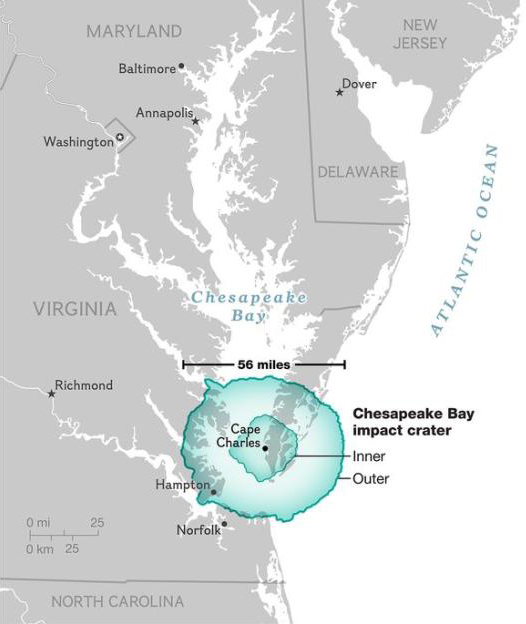Please click here for original article.

Above: More than a mile under the floor of the Chesapeake Bay, scientists have found ancient seawater, trapped there by an asteroid impact 35 million years ago. Image Courtesy: USGS
Scientists drilling the United States’ biggest crater have tapped into the oldest body of seawater ever found.
They weren’t expecting to find the ancient water, estimated to be 100 to 145 million years old, while boring a hole 1.1 miles (1.8 kilometers) deep into the massive crater, located under the Chesapeake Bay.
The crater was formed about 35 million years ago when a large rock or chunk of ice slammed into what’s now the mouth of the bay, off Cape Charles, Virginia, hollowing out a 56-mile-wide (90-kilometer-wide) hole in the floor of the North Atlantic Ocean.
“The water was in the sediment long before the impact occurred. The impact simply reshuffled the sediment in large blocks, which helped preserve it,” said study leader Ward Sanford, a hydrologist with the U.S. Geological Survey.
The asteroid wallup also spawned gigantic tsunamis that possibly hit the Blue Ridge Mountains more than 100 miles (160 kilometers) away. (See “Asteroid Impacts: 10 Biggest Known Hits.”)
The seawater trapped deep underground is now in an area roughly the size of a large lake—about 60 square miles (155 square kilometers) across.
Finding this unprecedented time capsule of Cretaceous seawater “was a little bit mind-blowing,” Sanford said.
Sanford and his colleagues drilled into the crater in 2005 during a joint project with the International Continental Scientific Drilling Program, but it took several years to gather additional data that could determine the water’s age.
How did they make the discovery?
To determine the origin of the newfound water, the team measured the ratio of two compounds—dissolved chloride and bromide—in the drilling samples, which revealed a clear “fingerprint” of ocean water, according to the study, published online November 13 in the journal Nature.
Pinpointing the age was a bit trickier. The scientists took samples of helium—a gas that accumulates over time in underground water—from nearby coastlines in the Chesapeake Bay. (Learn more about the Chesapeake.)
Then they sampled the helium in the ancient seawater, and discovered the concentration of the gas was about a hundred times higher than that of the other coastal samples.
By determining the rate at which helium accumulates, the team was able to figure out the rough age of the ancient water.
What does the discovery tell us?
The find appears to clear up the long-standing mystery of why previously collected samples of deep groundwater from the same region of the Chesapeake Bay are so salty.
Until now, scientists had various theories: Some proposed that buried salt in the rock slowly dissolved in the water. More recently, after the drilling under the crater in 2005, some suggested that the heat of the asteroid impact boiled much of the surrounding water and left it saltier than before.
But when the scientists finally determined the age of Sanford’s sample of water in 2012, they realized both the new specimens and previous groundwater specimens are seawater from a small section of the North Atlantic Ocean that has been trapped in place since the asteroid hit 35 million years ago. And they believe the water was just as salty then.
As North America was separating from Europe and Africa, geological rifts developed that created separate salty basins, including in the North Atlantic, notes Peter Swart, a marine geologist at the University of Miami who wasn’t involved in the new research.
Swart concurred with the recent study results concluding that the salty water under the crater has been that way for tens of millions of years, and did not become more salty over the millennia. (The majority of the ancient ocean wasn’t so salty, he added by email, or marine life would not have been able to flourish.)
Why is it important?
“Analyses of ancient seawater are very important in [that] they provide insight into the evolution of life” and other ocean processes, Swart noted.
For example, understanding how acidic the ocean was in the past may help people figure out how to tackle modern ocean acidification, a phenomenon harmful to some ocean animals that’s occurring due to global warming.
Study leader Sanford added the research also offers a window into how the ocean evolved: Before this study, no one knew for sure just how salty the North Atlantic was during the Cretaceous.
What’s next?
Drilling into the Chesapeake Bay crater has ended for now, but Sanford suspects that more water of this age and composition is sequestered elsewhere deep off the Atlantic Coast, waiting to be found.
“If you had enough money and drilling [resources], you could probably learn a lot,” he said.
Sanford was thrilled with his unexpected discovery, calling it “one of the highlights of my career.”
]]>




